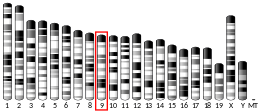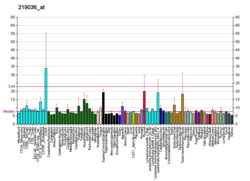CEP70
Centrosomal protein of 70 kDa is a protein that in humans is encoded by the CEP70 gene.[5][6] The protein interacts with γ-tubulin through its coiled coil domains to localize at the centrosome. CEP70 is involved in organizing microtubules in interphase cells and is required for proper organization and orientation of the mitotic spindle.[7]
References
- GRCh38: Ensembl release 89: ENSG00000114107 - Ensembl, May 2017
- GRCm38: Ensembl release 89: ENSMUSG00000056267 - Ensembl, May 2017
- "Human PubMed Reference:". National Center for Biotechnology Information, U.S. National Library of Medicine.
- "Mouse PubMed Reference:". National Center for Biotechnology Information, U.S. National Library of Medicine.
- Andersen JS, Wilkinson CJ, Mayor T, Mortensen P, Nigg EA, Mann M (Dec 2003). "Proteomic characterization of the human centrosome by protein correlation profiling". Nature. 426 (6966): 570–4. doi:10.1038/nature02166. PMID 14654843.
- "Entrez Gene: CEP70 centrosomal protein 70kDa".
- Shi X, Sun X, Liu M, Li D, Aneja R, Zhou J (September 2011). "CEP70 protein interacts with γ-tubulin to localize at the centrosome and is critical for mitotic spindle assembly". J. Biol. Chem. 286 (38): 33401–8. doi:10.1074/jbc.M111.252262. PMC 3190865. PMID 21795687.
External links
- Human CEP70 genome location and CEP70 gene details page in the UCSC Genome Browser.
Further reading
- Lim J, Hao T, Shaw C, et al. (2006). "A protein-protein interaction network for human inherited ataxias and disorders of Purkinje cell degeneration". Cell. 125 (4): 801–14. doi:10.1016/j.cell.2006.03.032. PMID 16713569.
- Rual JF, Venkatesan K, Hao T, et al. (2005). "Towards a proteome-scale map of the human protein-protein interaction network". Nature. 437 (7062): 1173–8. doi:10.1038/nature04209. PMID 16189514.
- Gerhard DS, Wagner L, Feingold EA, et al. (2004). "The Status, Quality, and Expansion of the NIH Full-Length cDNA Project: The Mammalian Gene Collection (MGC)". Genome Res. 14 (10B): 2121–7. doi:10.1101/gr.2596504. PMC 528928. PMID 15489334.
- Ota T, Suzuki Y, Nishikawa T, et al. (2004). "Complete sequencing and characterization of 21,243 full-length human cDNAs". Nat. Genet. 36 (1): 40–5. doi:10.1038/ng1285. PMID 14702039.
- Strausberg RL, Feingold EA, Grouse LH, et al. (2003). "Generation and initial analysis of more than 15,000 full-length human and mouse cDNA sequences". Proc. Natl. Acad. Sci. U.S.A. 99 (26): 16899–903. doi:10.1073/pnas.242603899. PMC 139241. PMID 12477932.
- Suzuki Y, Yoshitomo-Nakagawa K, Maruyama K, et al. (1997). "Construction and characterization of a full length-enriched and a 5'-end-enriched cDNA library". Gene. 200 (1–2): 149–56. doi:10.1016/S0378-1119(97)00411-3. PMID 9373149.
- Maruyama K, Sugano S (1994). "Oligo-capping: a simple method to replace the cap structure of eukaryotic mRNAs with oligoribonucleotides". Gene. 138 (1–2): 171–4. doi:10.1016/0378-1119(94)90802-8. PMID 8125298.
This article is issued from Wikipedia. The text is licensed under Creative Commons - Attribution - Sharealike. Additional terms may apply for the media files.




